On the Road is a weekday feature spotlighting reader photo submissions.
From the exotic to the familiar, whether you’re traveling or in your own backyard, we would love to see the world through your eyes.
This will not be the usual Albatrossity post – we have insects and butterflies, not birds! I have been assured that birds will return next week, though I’m sure that some of you will be thrilled with this insect post. :-)
After that it’s battleships (BretH) and lighthouses (Dangerman) and the last two days in Mendocino (JanieM).
Speaking of Mendocino, I miss your photos, Steve, surely you have more to share?
Albatrossity
No more baby birds for a while, and this week it’s not even birds! AL’s post yesterday about Pollinators is followed by more pollinators today. I have discovered that my camera rig (Olympus body affixed to an Olympus 150-400 zoom) is also great for insect photography. That lens is actually even longer (corresponding to a lens of 300-800 mm) in that setup, for reasons known only to physicists and wizards). So I can stand back at a great distance and, as long as my hands are steady, get images of insects who would be easily spooked by a close approach. Additionally, as is the case for birds in flight, this rig captures good images of insects in flight. So here is a summer collection, all taken with a camera/lens setup optimized for birds in flight! If you don’t like insects, tune in again next week for more birds.
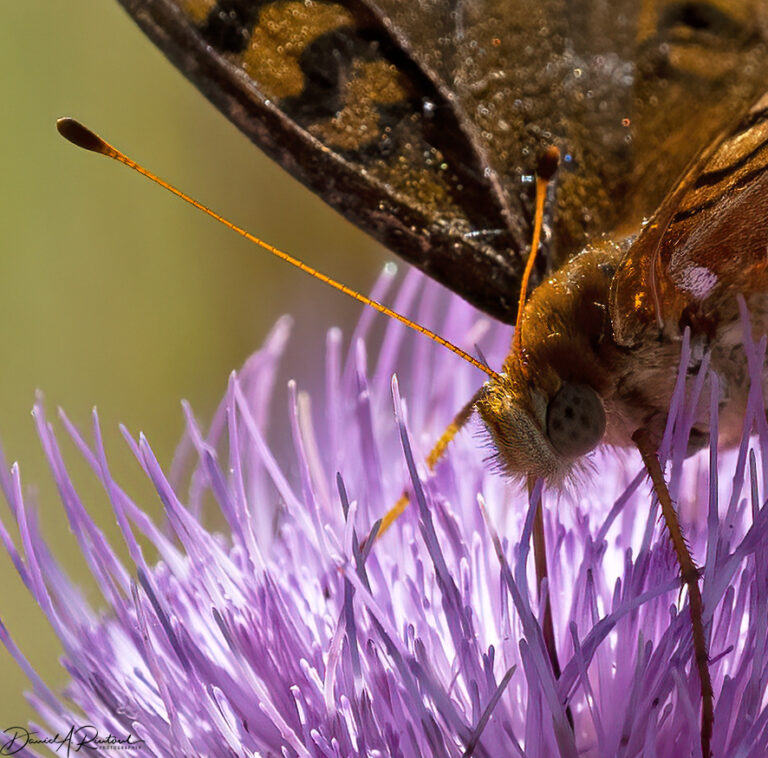
We have several kinds of fritillary butterflies around here in the summer; this might be the most common one. Great Spangled Fritillary (Speyeria cybele), nectaring on a thistle flower. If you want to know more about this species, or to find out if this beauty can be found in your area, the Butterflies and Moths of North America (BAMONA) site has range maps.
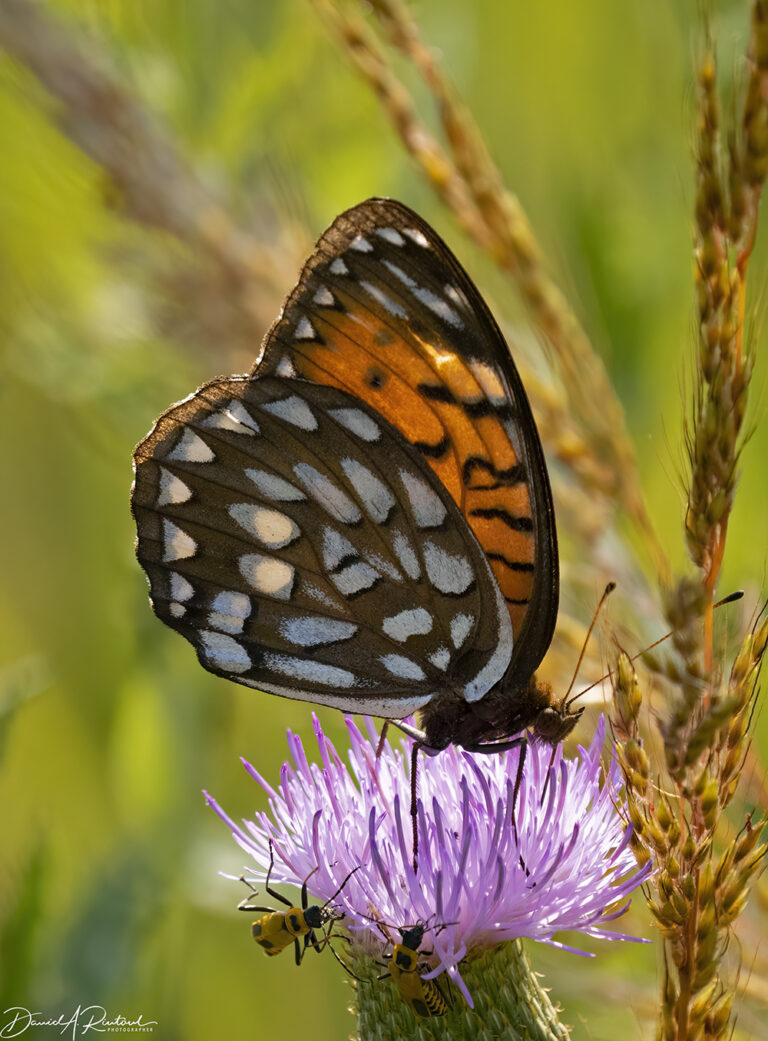
Another gorgeous large butterfly in this section of Flyover Country is the Regal Fritillary (Speyeria idalia). This is a tallgrass prairie specialist, and like that habitat, is much less abundant than it formerly was. It is on the threatened and/or endangered list throughout its diminished range. I was thrilled to find two of these in the same thistle patch that day!
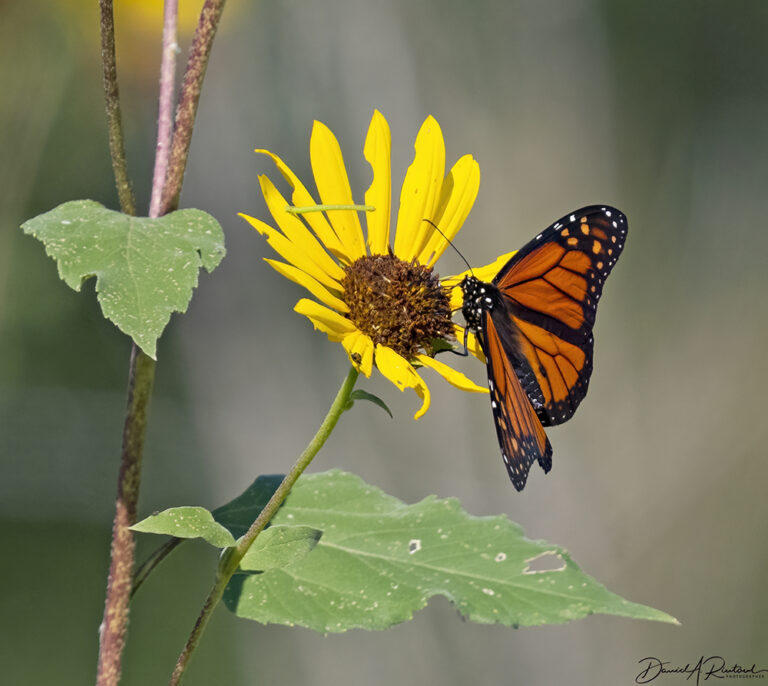
Another large (and very familiar) butterfly is the Monarch (Danaus plexippus). This September sighting is probably an individual heading back to Mexico for the winter, to a remote site that it (and its parent, grandparents, great grandparents and maybe further back) has never seen.
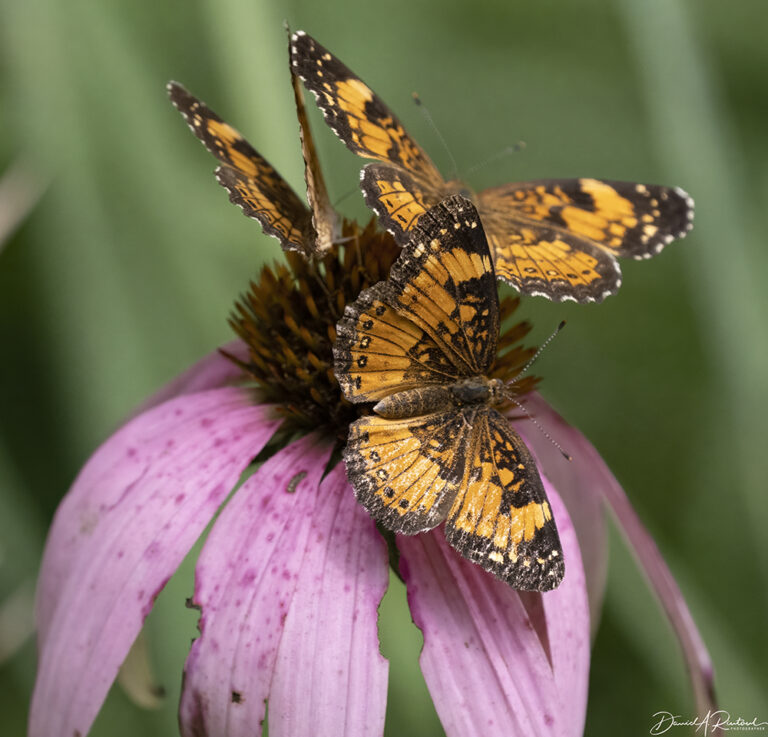
One of our less showy butterflies is the Silvery Checkerspot (Chlosyne nycteis), but they make up for that with sheer abundance. This patch of coneflowers had many checkerspots visiting, and the air was full of them.
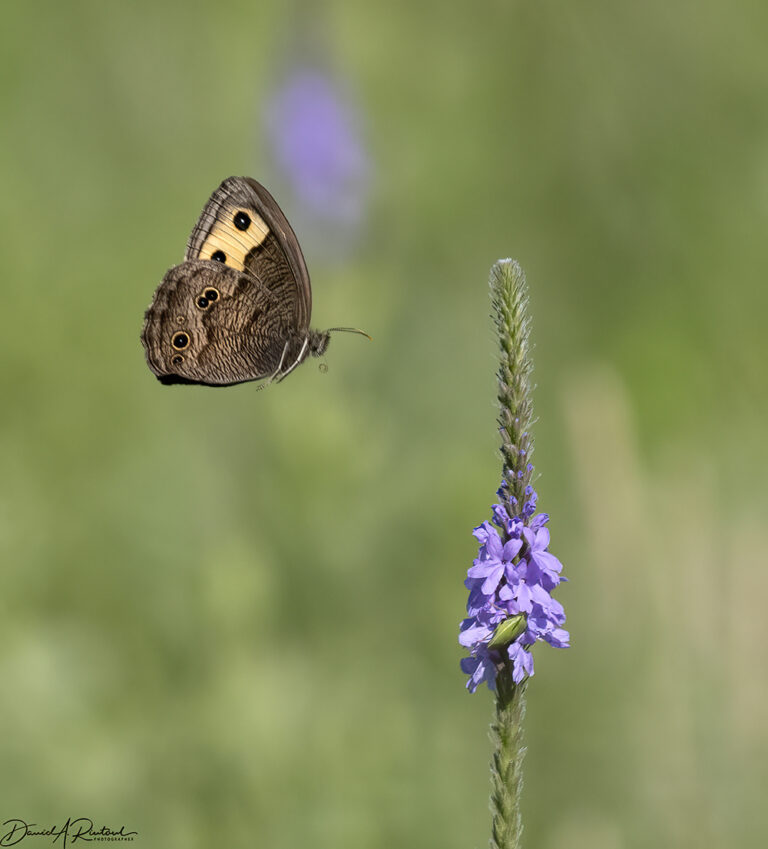
Butterfly in flight! Common Wood-nymph (Cercyonis pegala) approaching a verbena flower. I got lucky with this one, but I’ll take it!
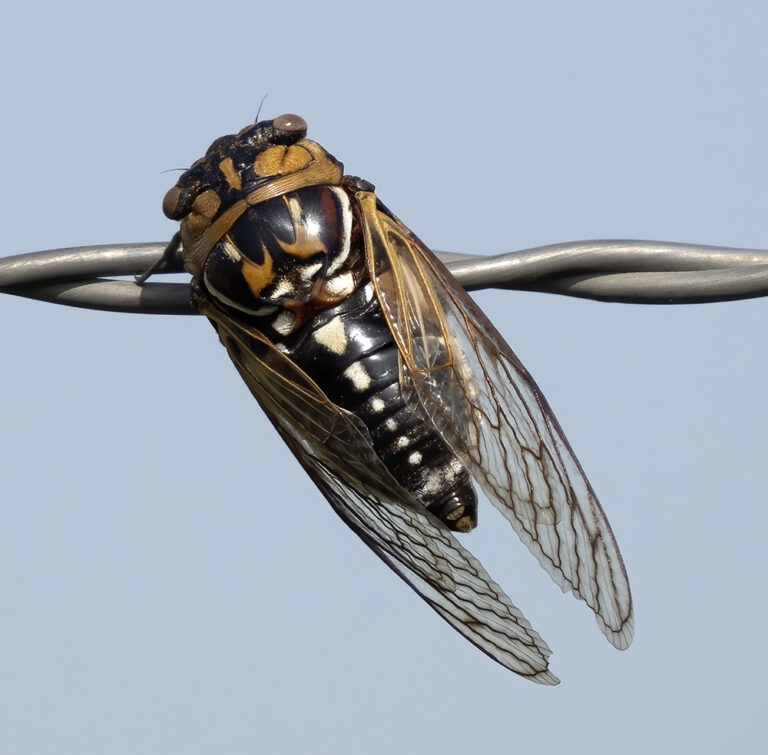
This insect is not in flight; in fact, it is not even alive. It’s a Bush Cicada/Giant Grassland Cicada (Megatibicen dorsatus), impaled on a barbed wire fence. Probably the work of a Loggerhead Shrike, but I have learned that Scissor-tailed Flycatchers sometimes do this as well. I did not see a bird, but both of those species can be found in that area. This cicada can be found across the eastern US, but it is mostly east of the Rockies and west of the Mississippi River.
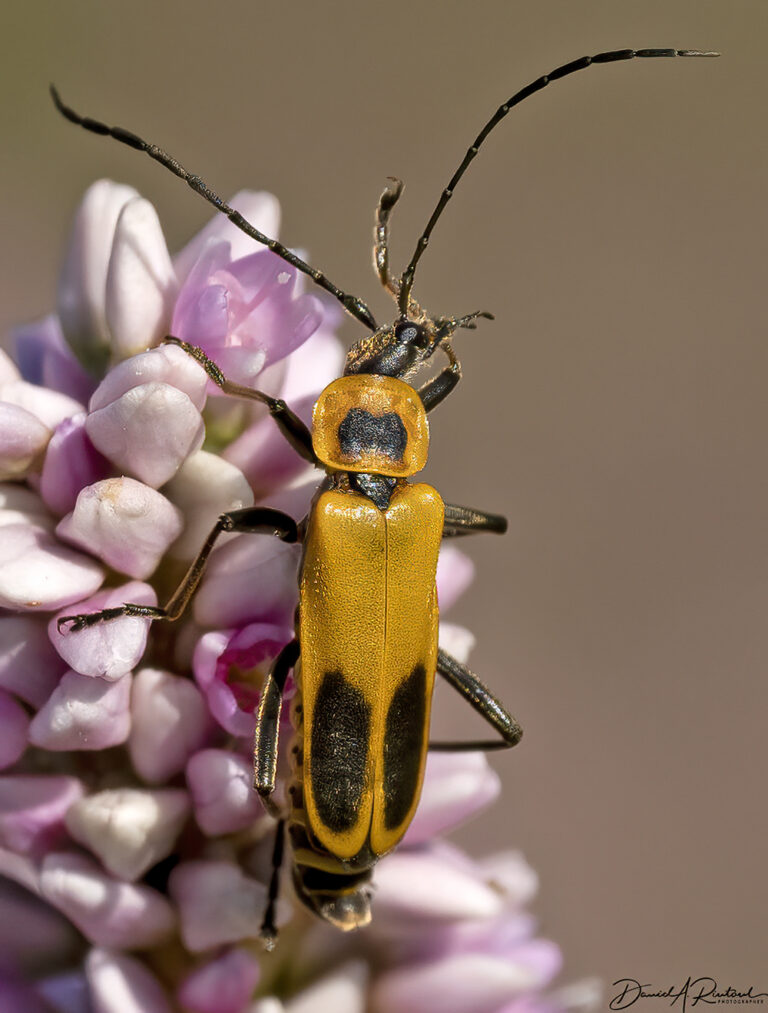
Another very common critter in this part of Flyover Country, as well as most of eastern North America wherever goldenrod is found, is the Goldenrod Soldier Beetle (Chauliognathus pensylvanicus). Just to be cantankerous, this one was perched not on goldenrod, but on smartweed. And yes, that specific epithet is not a typo. It was named at a time (1774) when spelling of Pennsylvania was variable. And the very explicit rules governing taxonomical names prohibit changing it to pennsylvanicus. Science can be weird.
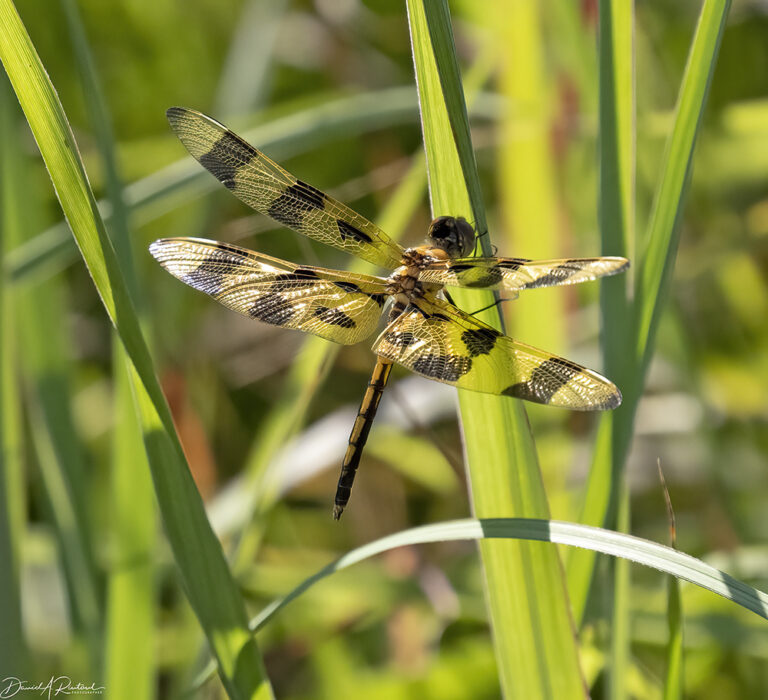
Next up is a dragonfly, which is also a group that some of my friends like to try to get in-flight pictures of. Not this time. This is a nice sedate Halloween Pennant (Celithemis eponina), also a species commonly seen across the eastern part of the continent (year-round in Florida). The group of dragonflies in the pennant category are named for their habit of perching at the top of plants and twigs, where they can wave in the breeze a lot. This one was free-lancing.
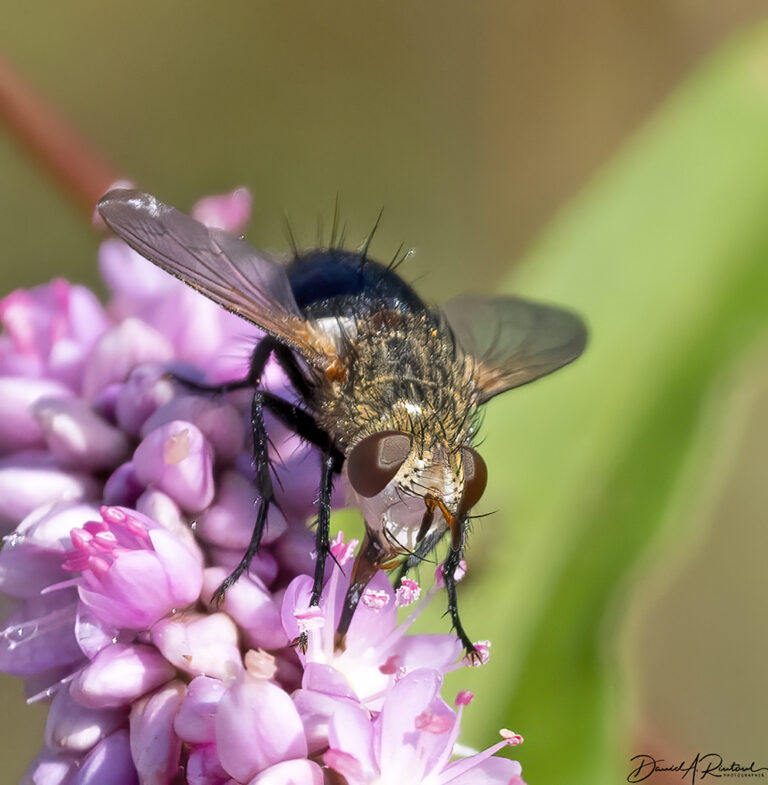
Another smartweed-loving insect is this tachinid fly. I have not tried to pin down the species of this one (there are over 1300 North American species in the family Tachinidae); expertise in IDing species in this group often requires a microscope, counting the number of bristles, etc.). All the flies in this family are parasitic, laying eggs on other insects or arthropods. Gardeners and lawn-lovers like to have some of these species around, since squash bugs and armyworms are among their victims.
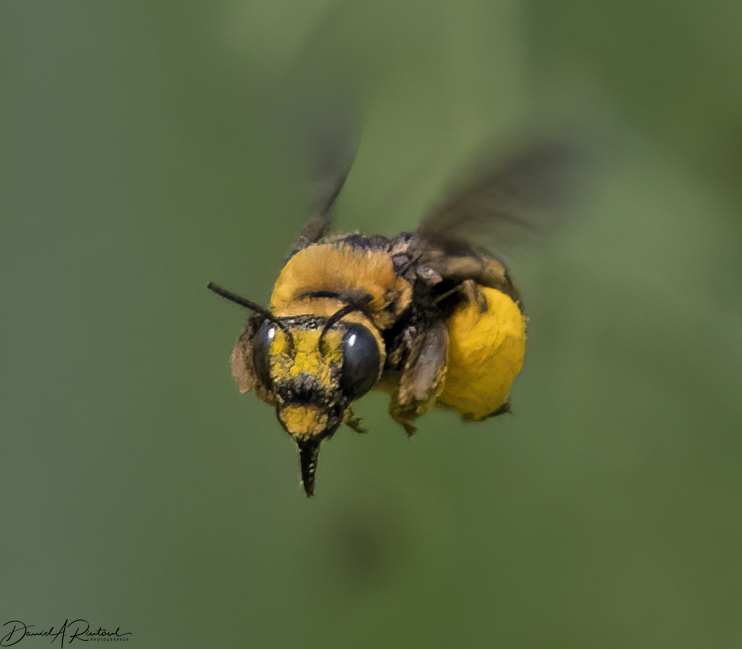
The final image for today is also unidentified down to species. It is a small bumblebee, loaded with sunflower pollen, that I caught in flight as it was approaching a blossom.

eclare
The butterflies on the coneflower are so pretty…
YY_Sima Qian
Wow! Taken w/ a macro lense?
Rob
I love these posts. Birds, insects, it doesn’t matter.
Wanderer
Absolutely perfect photos of creatures humans generally spend our efforts swatting away. They are beautiful.
Van Buren
Who are those guys with the Fritillary in the second photo?
Dorothy A. Winsor
@Wanderer: My very thought
Albatrossity
@YY_Sima Qian: No macro. just a very sharp telephoto lens. It helps when you have good light!
@Van Buren: The beetles who got a cameo appearance in the second photo are the same as the beetle featured in one of the subsequent photos – Goldenrod Soldier Beetle
OzarkHillbilly
Heh, I think you have birds on the brain, A. Butterflies and Moths of North America
Betty Cracker
Gorgeous photos! One very cool insect we see occasionally is the hummingbird moth. I’ve never managed to get a decent picture of one.
Mike S (Now with a Democratic Congressperson!)
Great pics! Besides birds my second love is insects and their interactions with plants.
I have gotten into doing bee ID projects in the last 10 years or so. (I’m about to start a one year project to ID older specimens for the Pennsylvania Natural Heritage Program) Id love to have that bee in the last picture under a microscope because I’m pretty poor at ID’ing bees from pictures! Do you have any other pics of it? I’m fairly certain it’s not a bumblebee (Bombus sp.) and my guess would be a mining bee (Andrena sp.), but there are other possibilities. Those enlarged forelegs look pretty distinctive!
Mike S (Now with a Democratic Congressperson!)
@Betty Cracker: For me video works better for the hummingbird moths. I have a Nikon P1000 which is similar to your P900 and I have some decent video of them at our Monarda flowers in our yard.
Albatrossity
@Mike S (Now with a Democratic Congressperson!): Thanks! It was smallish, not as big as most bumblebees around here. I dunno if it can be IDed from pictures, but I do have a couple more images I could send along if you are inclined to dig in further. Let me know your email address, I can be reached at albatrossity AT pm.me
Mike S (Now with a Democratic Congressperson!)
@Albatrossity: Email sent!
pat
I started taking photos of bugs on flowers a few years ago. (Tamron 16-300mm, I can focus a few inches away and the bugs don’t seem to mind).
But the last couple of years I am seeing many fewer bugs. Wondering if you have noticed that?
Great photos, btw, the detail! Wow.
C Stars
These images are just delightful, as are some of the names of the species. Soldiers and pennants and checkerspots!
apieceofpeace
Great photos for beginning a morning. Thank you – for sharing the beauty-side. Love the bee, yellow dusted from all that foraging!
We have few butterflies in comparison to 10 years ago, perhaps because of not only climate changes, but pesticides, garden chemicals, and the like, that do their damage as well? I miss them, even the occasional fly.
arrieve
Beautiful way to start the day. I was in Costa Rica for several weeks this summer doing a school program, and found the butterflies almost as fascinating as the birds. And almost as hard to photograph! But I sadly lack Albatrossity’s talent for capturing creatures in flight.
J R in WV
Just WOW — esp that little bee, so loaded down with loot from visiting many, many flowers. Marvel that it can still fly, so loaded down!
Thanks so much for sharing so much so often! Always a high point for me to see your photos!
MobiusKlein
My San Francisco backyard has been converted from grass (*hahah* I mean Oxalis) to native plants and hemp, and the butterflies are going nuts. Especially the Fritillary, with 7+ chasing each other to get busy, and lay yet more eggs.
Sadly, I have dropped my telephoto one or two too many times. Lost some sharp focus and the image stabilizer. Repair is possible, but I’m tempted to get a new lens instead.
StringOnAStick
My garden mantra is Plant for Pollinators and Less (or no) lawn.
Watching the British Gardeners World program two weeks ago, the discussion about the severe lack of rain all summer was interesting, including the toss off remark that “of course we don’t water grass, it will come back when it rains” was so refreshing. Yet here we water grass because of course you must have a green suburban lawn. The whole idea of lawns is a British import and originally was how the rich showed their wealth by having land that didn’t need to be in production and that you could afford the workers to scythe it. Where we live gets 15″ of precipitation annually, but to have a lawn requires 35″ of irrigation water while the western drought drag s on and our aquifers are declining. This is not sustainable.
BigJimSlade
Great shots – especially the butterfly in flight! I have an Olympus, but my zoom only goes to 150. Now I’m inspired to check the longer offerings!
Albatrossity
@OzarkHillbilly: Thanks! Fixed now
Joy in FL
Beautiful photos. Thank you for sharing them.
Munira
Amazing photos.
mvr
Thanks for this!
Yesterday I was looking at a garden bed by my office which was mobbed by butterflies that looked similar to Monarchs, especially on the inside of the wing but not as much on the lower outside of the wing. Then this morning I finally find time to run down yesterday’s Albatrossity post and it sure seems that these might be Regal Fritillary as pictured above.
I’ll have to see if they are still there to check.
Albatrossity
@mvr: Could also be Viceroy, which look very similar to Monarchs
mvr
@Albatrossity: I don’t think these are Viceroys but after googling I’m not sure what they are. There are a lot of options in Google’s photos, though I’m not quite getting an “AHA that’s it” reaction. I need to look more closely. If I recall correctly the antenna had a ball-like end.